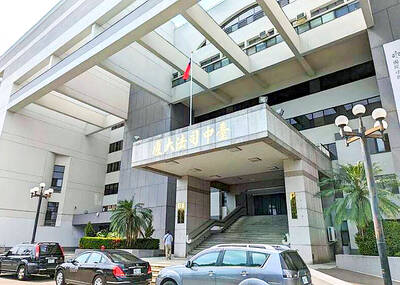Ninety-three-year-old Wang King-ho (王金河) looks like an ordinary grandfather, but there is more to him than meets the eye — a painful story set in the coastal area of southern Taiwan.
Back in the late 1950s, a mystery illness dubbed by locals as “Blackfoot disease” afflicted several townships in Tainan and Chiayi counties including Hsuehchia (學甲), Beiman (北門), Budai (布袋) and Yijhu (義竹), where residents mainly depended on deep wells for drinking water.
“The wells they drilled became deeper and deeper because water from shallow wells tasted too salty as a result of the local salt industry,” said Shin Ya-ping (施雅屏), a staffer from the Southwest Coast National Scenic Area Administration.
But people in the townships did not know the water they drank everyday contained arsenic, which led to the chronic poisoning of local residents, Shin said.
As its name suggests, Blackfoot disease started with the tips of a patient’s limbs — usually their feet — turning black. What often followed the change of color was death of tissue (necrosis) and extreme pain as patients’ blood vessels were unable to deliver nutrients to tissues at the peripheries of their limbs.
Patients usually had to endure multiple amputations as necroses recurred on remaining parts of their limbs.
In addition to physical pain, patients were often shunned as the disease was considered a punishment from the gods.
The condition existed for years before Wang, then a 44-year-old doctor who had studied medicine in Tokyo, came onto the scene.
At the invitation of Lilian Dickson, a US missionary and founder of the Mustard Seed Mission, Wang established the nation’s first and only free clinic for patients with Blackfoot disease in 1960.
“I treated 2,000 to 3,000 patients suffering from [Blackfoot disease] during my 35 years of practice, with the youngest being a five-year-old child,” Wang said in an interview with the Taipei Times in front of his old clinic in Beimen Township.
Wang and Hsieh Wei (謝緯) — a doctor from Puli Township (埔里) in Nantou County — performed amputations inside the small clinic, while Dickson and the mission raised funds to support their work.
“I still remember that one of the patients was a very beautiful bride-to-be,” said Wang Hsiu-yun (王琇雲), a nurse who joined Wang King-ho’s practice in her teens.
“When she was diagnosed with the illness, she kept crying and didn’t want to have her foot amputated,” Wang Hsiu-yun said.
Some patients could not be saved so Wang and his two nurses also made coffins and helped bury them.
“My mother warned me that I could end up being single for the rest of my life because no man would dare to marry me since I helped Dr Wang carry the coffins,” Wang Hsiu-yun said.
Over the years, the clinic also sheltered patients who were rejected by their own families. At one point, the number of patients the small structure housed reached about 80 people.
To encourage patients who had become disillusioned as a result of the physical and psychological pain, Wang King-ho launched a handicraft training class at the back of the clinic in the hope that they could at least acquire some skills.
Wang and his wife Mao Pi-mei (毛碧梅) ran the class for 17 years before the Taiwan provincial government took over in 1978.
Though the provincial government also established an official Blackfoot disease prevention center in Beiman in 1977, Wang did not end his practice until 1996 — 50 years after he first started practicing medicine.
Although Wang saw many deaths and much suffering during his three decades of treating the disease, he said he never felt discouraged.
“I did not become a doctor in order to make more money. That’s why I did not lose my spirit after having treated so many patients,” Wang said.
Wang’s old clinic — a modest Japanese-style one-story wooden structure — was designated as the Taiwan Blackfoot Disease Socio-Medical Service Memorial House at the end of September 2007 to commemorate Wang’s selfless dedication and the history of a disease unique to Taiwan.
The house faithfully recreates Wang’s operating room as it was 30 years ago and has a set of patients’ amputated feet preserved in formaldehyde.
“The memorial house now serves as a witness of Taiwan’s 30-years of Blackfoot disease. It can also help pass on Dr Wang’s spirit,” said Wang Hsiu-yun, who returned to Beiman as a volunteer at the house after learning of the opening of the memorial.
“Dr Wang often delivers speeches to medical students,” she said. “He usually tells them that even though it is great for them to be able to make a lot of money [by becoming a doctor], sometimes doing volunteer work can bring happiness that they cannot buy.”

The first global hotel Keys Selection by the Michelin Guide includes four hotels in Taiwan, Michelin announced yesterday. All four received the “Michelin One Key,” indicating guests are to experience a “very special stay” at any of the locations as the establishments are “a true gem with personality. Service always goes the extra mile, and the hotel provides much more than others in its price range.” Of the four hotels, three are located in Taipei and one in Taichung. In Taipei, the One Key accolades were awarded to the Capella Taipei, Kimpton Da An Taipei and Mandarin Oriental Taipei. Capella Taipei was described by

The Taichung District Court yesterday confirmed its final ruling that the marriage between teenage heir Lai (賴) and a man surnamed Hsia (夏) was legally invalid, preventing Hsia from inheriting Lai’s NT$500 million (US$16.37 million) estate. The court confirmed that Hsia chose not to appeal the civil judgement after the court handed down its ruling in June, making the decision final. In the June ruling, the court said that Lai, 18, and Hsia, 26, showed “no mutual admiration before the marriage” and that their interactions were “distant and unfamiliar.” The judge concluded that the couple lacked the “true intention of

EVA Airways today confirmed the death of a flight attendant on Saturday upon their return to Taiwan and said an internal investigation has been launched, as criticism mounted over a social media post accusing the airline of failing to offer sufficient employee protections. According to the post, the flight attendant complained of feeling sick on board a flight, but was unable to take sick leave or access medical care. The crew member allegedly did not receive assistance from the chief purser, who failed to heed their requests for medical attention or call an ambulance once the flight landed, the post said. As sick

INDUSTRY: Beijing’s latest export measures go beyond targeting the US and would likely affect any country that uses Chinese rare earths or related tech, an academic said Taiwanese industries could face significant disruption from China’s newly tightened export controls on rare earth elements, as much of Taiwan’s supply indirectly depends on Chinese materials processed in Japan, a local expert said yesterday. Kristy Hsu (徐遵慈), director of the Taiwan ASEAN Studies Center at the Chung-Hua Institution for Economic Research, said that China’s latest export measures go far beyond targeting the US and would likely affect any country that uses Chinese rare earths or related technologies. With Japan and Southeast Asian countries among those expected to be hit, Taiwan could feel the impact through its reliance on Japanese-made semi-finished products and